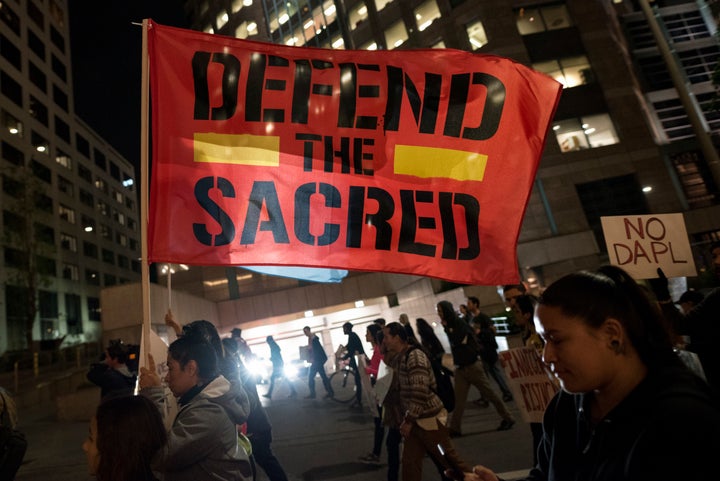
The long-standing Dakota Access Pipeline (DAPL) protests at Standing Rock took months to reach the media in 2016. Though there were some communications coming through social media, there was a noticeable lack of coverage on major media networks. When stories did start reaching the national media’s attention, they focused on the protesters themselves.
Celebrities, social justice groups, environmental groups, and veterans traveled to North Dakota to stand with the local tribes. Over a million people “checked in” on Facebook to Standing Rock to bring attention to the protests. Clashes between protesters and police intensified. Various donation portals launched through sites like FundRazr, and GoFundMe collected millions of dollars for the Sacred Stone Camp. The Camp was established in April 2016 to stop further construction of the DAPL and bring awareness about the severity of the situation. Then, in December 2016, The Department of the Army announced that it would “not approve an easement” for further construction of the pipeline under Lake Oahe in North Dakota. The Standing Rock Sioux, “water protectors,” and advocates across social media celebrated the announcement as a major victory for environmental and social justice groups, and the Sioux tribe.
The victory was short-lived. On January 24, the new president advanced construction of the Dakota Access Pipeline through an executive order. President Trump’s memorandum states, “I believe that construction and operation of lawfully permitted pipeline infrastructure serve the national interest.” By “national interest,” he was certainly not including the health, livelihood, and well-being of American Indian communities.
Donald Warne, MD, MPH, is the chair of the Department of Public Health at North Dakota State University as well as the senior policy advisor to the Great Plains Tribal Chairmen’s Health Board. For Dr. Warne, Standing Rock isn’t just an issue of water quality, it is an issue of environmental racism. According to Dr. Warne, the original plan for the DAPL was to have it run north of Bismarck. However, since the people of Bismarck did not want to be downstream from the pipeline, the plans were changed to build the pipeline to the south.
“Now it’s located upstream from the tribal population,” Warne said. “So, in many ways, it’s an environmental justice and an environmental racism issue. The decisions were made to put the pipeline in a place where American Indians feel like their water supply is put at risk … . However, when the non-Indian population of Bismarck was concerned, then they made accommodations.”
Standing Rock isn’t the only place where this type of environmental injustice is happening to American Indians. Dr. Warne cited an example of mining activities in New Mexico and water contamination in Colorado. As a result of toxic remnants spilling into the San Juan River and contaminating water used by the Navajo Nation, the tribe ended up having to sue the EPA for “negligence in cleaning up the disaster.”
Dr. Warne also warns that environmental health issues not only result from adding toxins to the environment, but from preventing access to resources. The damming of rivers, for example, is another environmental concern for American Indians, specifically for those in the Southwest and in the Northern Plains. The issues are “not [about] just adding something bad, but taking away something good,” according to Warne.
“With the Trump administration, the future of Standing Rock and environmental justice for American Indians is uncertain.”
For some of us who feel physically or geographically distant from events in North Dakota, remember that the Standing Rock Sioux are not the only marginalized population of people in America who lack adequate resources, equality, and media attention.
“In modern American society, if you live in a wealthy community, the odds of being exposed to environmental toxins are much lower than if you lived in an impoverished community,” Warne said. “It just happens to be that American Indians are among the most impoverished in the nation, particularly here in the Northern Plains.”
With the Trump administration, the future of Standing Rock and environmental justice for American Indians is uncertain. However, these infringements to justice extend well beyond the treatment of Standing Rock’s protesters. The future of health care under the Trump Administration brings a whole new set of threats to native communities throughout the United States.
The Indian Health Care Improvement Act (IHCIA) was officially reauthorized when President Obama signed the bill for the Affordable Care Act in 2010. Though many Americans are concerned about the future of health care, a “repeal and replace” of the ACA could be disastrous for American Indians and Alaska Natives. In a release titled, “Impacts of Healthcare Reform on Indian Country,” the National Indian Health Board states, “Repealing these specific provisions of the ACA would have devastating impacts on the health of American Indians and Alaska Natives (AI/ANs) and would end critical cost-saving and life-saving modernizations that have been the result of the enactment of the ACA.”
If you aren’t able to physically join the water protectors at Standing Rock or other #NoDAPL protests, there are still ways that you can be an advocate for American Indians and Alaska Natives. “We have federally recognized tribes in 35 states,” Warne said. “So what that means is there are 15 states with no federally recognized tribes. Therefore, 30 percent of the Senate, for example, has no tribes in their constituency so our issues are not treated with the same degree of importance as other populations.”
American Indians and Alaska Natives need your voice. Here are a few ideas on how to get started:
1. Learn more about American Indian Health needs, the Indian Health Care Improvement Act, and the consequences of repealing the ACA.
2. Whether you live in a state with federally recognized tribes or not, contact your representatives and voice your support for the Indian Health Care Improvement Act.
3. Circulate news concerning American Indian and Alaska Native health and environmental justice via social media. Remember, Standing Rock reached national media attention largely due to social media engagement.
4. Engage in media advocacy, and hold media outlets accountable for the accuracy of their reporting on American Indian and Alaska Native issues. Misinformation is just as harmful as no information.
5. Donate. The Sacred Stone Camp isn’t the only place defending against injustice. Check out the National Indian Health Board or Native American Journalists Association for a start.
6. Stay informed. These struggles will not be resolved by or end with this administration. Start establishing yourself now as a lifelong advocate for American Indians and Alaska Natives.
